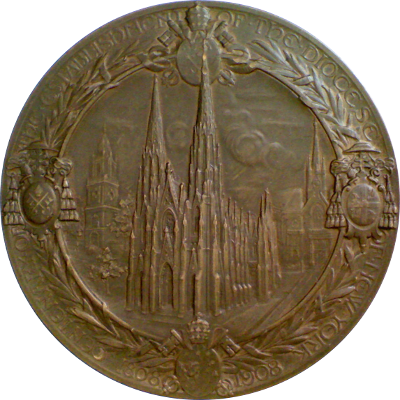Medals relating to Churches and Religion
As always, you can click or tap medals to see the reverse. Some medals might have multiple variants that differ in material, size, or other details. If multiple variants are available you can drag or slide medals sideways to display them.


This medal was the 21st official issue of the American Numismatic Society.
The obverse bears portraits of the seven archbishops who presided over the Diocese of New York during its first century. Archbishop Farley in the center.
The reverse displays a view of St. Patrick's Cathedral in he center; at sides, partial representations if St. Peter's Church of 1808 on Barclay Street and St. Patrick's Church on Mott Street. consecrated in 1815. Four coats of arms entwined in a wreat at the sides.
Edge contains maker's mark, MED. ART CO & (D within diamond);
This medal was issued by both the American Numismatic Society (ANS) and the Catholic Diocese of New York. Only medals which bear edge numbers were issued by the ANS. One medal in gold was presented to Pope Pius X. Silver and bronze medals with the edge number 1 were presented to Archbishop Farley and 100 medals each in silver and bronze (numbered 2-101) were for ANS members. There is an unknown number of silver and bronze medals struck without numbers for the Diocese.
The medal measures 76mm in diameter and was struck by the Medallic Art Company of New York. The reported mintage is 1 piece in gold, and 101 each in bronze and silver.
References: Baxter 299


This medal's obverse bears bust of Gibbons facing right. Around, JAMES CARDINAL GIBBONS
The reverse bears a view of Baltimore Basilica above coat of arms. Around, SACERDOS · 30 · JUN · 1861 ✝ EPISCOPUS · 16 · AUG 1868 (crozier) ARCHIEPISCOPUS · 3 · OCT · 1877 ☨ CARDINALIS · 30 · JUN · 1886; to left and right of coat of arms, 1861 - 1911
James Cardinal Gibbons was only the second American to attain the rank of Cardinal in the Catholic Church. Born to Irish immigrants, he became a priest in 1861 after recovering from severe Malaria that had left him too weak to be ordained four years earlier. Gibbons was controversial on several issues. He was a strong supporter of workers' causes and was instrumental in securing papal permission for Catholics to organize in labor unions. He also took a position in support of the King of Belgium and against clergy who were complaining against exploitative colonial practices.
Mencken, often a harsh critic of Christian ministers, wrote in 1921 after the Gibbons' death:
"More presidents than one sought the counsel of Cardinal Gibbons: he was a man of the highest sagacity, a politician in the best sense, and there is no record that he ever led the Church into a bog or up a blind alley. He had Rome against him often, but he always won in the end, for he was always right."
This medal was issued as part of Gibbons' golden jubilee celebration where President Taft honored him for his contributions.
The circular medal measures 70mm in diameter and was struck in bronze by the Medallic Art Company of New York.
References: MACo 1911-001


This is the 33rd official issue of the American Numismatic Society.
The obverse bears St. Bartholomew standing in front of cityscape, a model of the church in his left hand; to his right is a shield bearing a flaying knife. At his feet, MAY 1ST AD / MDCC CCXVII (ANS seal); Around, ✝ IN COMMEMORATION OF THE LAYING OF THE CORNERSTONE OF S BARTHOLOMEWS CHURCH
The reverse bears cruciform composed of the shields of the Episcopal Diocese of New York, St. Bartholomew's Church, New York City, and the United States; in center round, a sailing ship. Around, BEHOLD THE TABERNACLE OF GOD WITH MEN & HE WILL DWELL WITH THEM
The circular medal comes in two sizes, 51mm and 38mm in diameter, and was struck by the Medallic Art Company of New York. The mintage is 3 pieces in gold (51mm), at least 11 pieces in silver (51mm) and an unknown number of large and small pieces in bronze.


The obverse bears old Trinity Church building within central roundel. Around, 250TH ANNIVERSARY / 1697; signed at lower right of field, (JF monogram).
The reverse bears present building of the Trinity Church. Around, TRINITY CHURCH IN THE CITY OF NEW YORK / 1947.
The edge is marked J.FONSON
In 1696, Governor Benjamin Fletcher approved the purchase of land in Lower Manhattan by the Church of England community for construction of a new church. The parish received its charter from King William III on May 6, 1697. Its land grant specified an annual rent of sixty bushels of wheat. The first rector was William Vesey (for whom nearby Vesey Street is named), a protege of Increase Mather, who served for 49 years until his death in 1746.
The first Trinity Church building, a modest rectangular structure with a gambrel roof and small porch, was constructed in 1698. According to historical records, Captain William Kidd lent the runner and tackle from his ship for hoisting the stones. The church was destroyed in the Great New York City Fire of 1776, which started in the Fighting Cocks Tavern, destroying nearly 500 buildings and houses and leaving thousands of New Yorkers homeless. Six days later, most of the city's volunteer firemen followed General Washington north.
A second church was built and consecrated in 1790 but it had to be torn down after it had been weakened by severe snow in the winter of 1838-39. The third and current Trinity Church was finished in 1846 and at the time of its completion its 281-foot (86 m) spire and cross was the highest point in New York until being surpassed in 1890 by the New York World Building.
This medal measures 60mm (2 3/8in) in diameter.